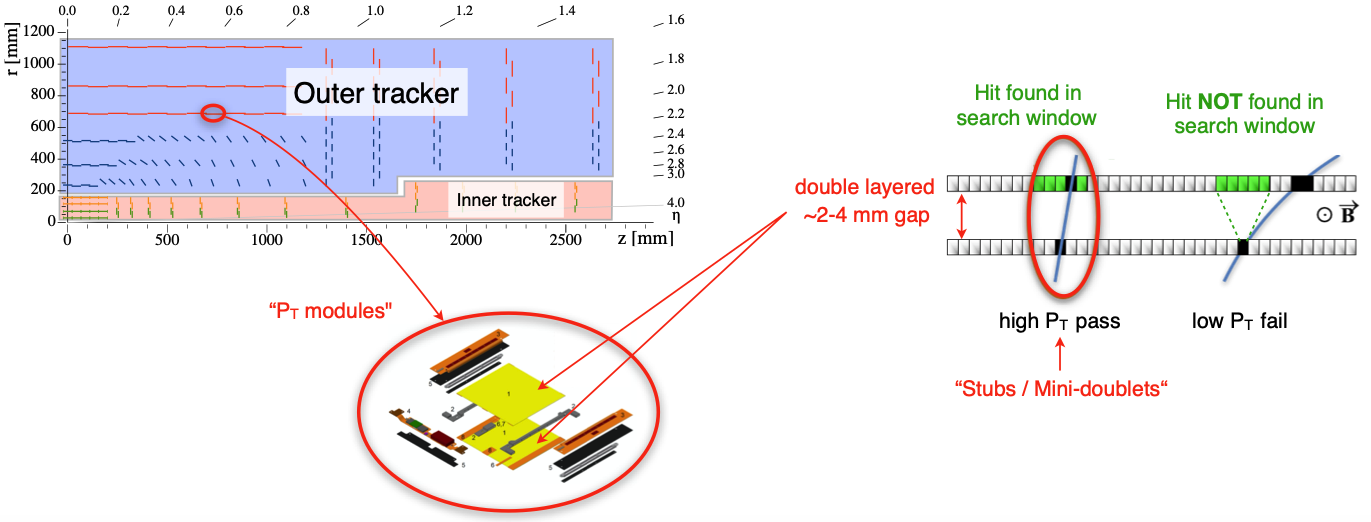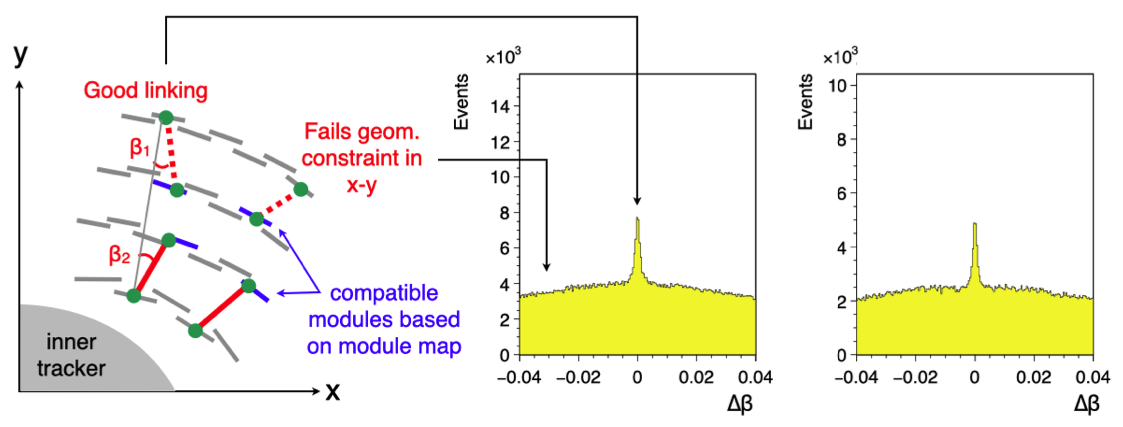Line-Segment tracking
Development
Line-segment tracking aims to exploit the CMS outer tracker geometry to make an inherently parallelizable and acceleratable tracking algorithm.
CMS outer tracker geometry
The planned CMS tracker design contains double-layered silicon modules with a gap size of about 2mm (dubbed pT modules) in the outer tracker. This geometry can be used to reduce occupancy of hits by requiring coincidences of hits between two layers consistent with a minimum pT threshold.

Approach
Here we illustrate the segment linking algorithm in the outer tracker. The first graphic shows the creation of mini-doublets from detector hits and then segments from the mini-doublets. Segments are advantageous for a number of reasons including locality, sharing hits, and being inherently not dependent on the inner tracker layers. The right-hand figure then shows how track candidates are created from segments. (a non-exhaustive list of possible track candidates are shown).

Results
Good (or poor) linking is then an indicator of a valid track candidate. Geometric variables distinguish good track candidates from unphysical ones. This approach is naturally parallelizable and vectorizable (quite different from a traditional Kalman-Filter approach). We are developing this algorithm with both CPU and GPU (CUDA) implementations.

Team
- Avi Yagil
- Philip Chang
- Peter Wittich
- Peter Elmer
- Steve Lantz
- Michael (Tres) Reid
- Dan Riley
- Gavin Niendorf
- Leonardo Giannini
- Slava Krutelyov
- Mario Masciovecchio
- Matevz Tadel
- Emmanouil Vourliotis
- Bei Wang
- Giuseppe Cerati
- Matti Kortelainen
- Allison Reinsvold Hall
- Brian Gravelle
- Boyana Norris
Presentations
- 25 Jul 2025 - "Line Segment Tracking: Particle Tracking on GPUs", Gavin Niendorf, Seventh Computational and Data Science school for HEP (CoDaS-HEP 2025)
- 3 Dec 2024 - "LST in Phase 2 HLT: Configurations with (Single Iteration) Patatrack", Emmanouil Vourliotis, HLT Upgrade (CMS restricted)
- 17 Sep 2024 - "Updates on the LST integration in CMSSW", Slava Krutelyov, CMS GPU developments for Phase-2 Meeting (CMS restricted)
- 17 Sep 2024 - "The Line Segment Tracking Algorithm in the CMS Phase 2 High Level Trigger (poster)", Emmanouil Vourliotis, CMS Upgrade Week (CMS restricted)
- 9 Sep 2024 - "Line Segment Tracking: status and plans", Gavin Niendorf, CMS Tracking POG Meeting (CMS restricted)
- 5 Sep 2024 - "CMS Tracking: LST", Slava Krutelyov, IRIS-HEP Institute Retreat
- 17 Jun 2024 - "Line Segment Tracking: integration in CMSSW and recent updates", Emmanouil Vourliotis, CMS Tracking POG Meeting (CMS restricted)
- 3 Jun 2024 - "Line Segment Tracking: CMSSW PR plans", Emmanouil Vourliotis, CMS Tracking POG Meeting (CMS restricted)
- 12 Apr 2024 - "Line Segment Tracking", Emmanouil Vourliotis, Phase-2 Software Days (CMS restricted)
- 11 Mar 2024 - "Line Segment Tracking: Improving the Phase 2 CMS High Level Trigger Tracking with a Novel, Hardware-Agnostic Pattern Recognition Algorithm", Emmanouil Vourliotis, 22nd International Workshop on Advanced Computing and Analysis Techniques in Physics Research (ACAT 2024)
- 21 Feb 2024 - "DPS Note: Performance of Line Segment Tracking in the CMS Phase 2 High Level Trigger", Emmanouil Vourliotis, Trigger Studies Group (CMS restricted)
- 31 Jan 2024 - "Improving the line-segment tracking algorithm with machine learning for the High Luminosity LHC", Jonathan Guiang, 6th Inter-experiment Machine Learning Workshop
- 3 Nov 2023 - "Phase-2 Timing projections: Tracking", Emmanouil Vourliotis, Reconstruction and Analysis Tools (CMS restricted)
- 12 Oct 2023 - "Improving tracking algorithms with machine learning: a case for line-segment tracking at the High Luminosity LHC", Jonathan Guiang, Connecting The Dots 2023
- 11 Sep 2023 - "mkFit/LST", Slava Krutelyov, IRIS-HEP Institute Retreat
- 10 Jul 2023 - "Timing considerations for LST", Emmanouil Vourliotis, HLT developments with GPUs (CMS restricted)
- 9 May 2023 - "Line Segment Tracking in the High-luminosity LHC", Philip Chang, 26th International Conference on Computing in High Energy and Nuclear Physics (ICHEP 2023)
- 13 Mar 2023 - "Integration of Line Segment Tracking in CMSSW", Emmanouil Vourliotis, CMS Tracking POG General Meeting (CMS restricted)
- 10 Mar 2023 - "Line Segment Tracking (LST)", Emmanouil Vourliotis, Phase-2 Software Days (CMS restricted)
- 10 Mar 2023 - "Tracking", Emmanouil Vourliotis, Phase-2 Software Days (CMS restricted)
- 9 Mar 2023 - "Line Segment Tracking (LST)", Emmanouil Vourliotis, CMS Upgrade Software Days (CMS restricted)
- 2 Mar 2023 - "Future tracking", Emmanouil Vourliotis, CMS Tracker Training Days (CMS restricted)
- 11 Nov 2022 - "Effect of the Outer Tracker Inefficiencies on the LST Algorithm", Emmanouil Vourliotis, CMS Tracker Upgrade Modelling, Simulation and Performance (CMS restricted)
- 5 Aug 2022 - "Example application: Line Segment Linking project", Michael (Tres) Reid, CoDaS-HEP school
- 27 Jul 2022 - "Update on Line Segment Tracking for Phase-2 tracking", Emmanouil Vourliotis, CMS Tracker DPG - Tracking POG General Meeting (CMS restricted)
- 17 Jun 2022 - "Segment Linking: A Highly Parallelizable Track Reconstruction Algorithm for HL-LHC", Emmanouil Vourliotis, HEP 2022 - 39th Conference on Recent Developments in High Energy Physics and Cosmology
- 13 Apr 2022 - "Line Segment Linking project", Michael (Tres) Reid, IRIS-HEP Topical meeting
- 18 Oct 2021 - "Line segment tracking for Phase-II Tracking", Philip Chang, HLT Upgrade Workshop (CMS restricted)
- 7 Dec 2020 - "Segment Linking Development on GPUs", Michael (Tres) Reid, HLT developments with GPUs
- 3 Nov 2020 - "Line segment tracking for Phase-II Tracking", Philip Chang, HLT Upgrade Workshop (CMS restricted)
- 21 Sep 2020 - "Update on Segment Linking for HL-LHC", Philip Chang, Tracking POG meeting (CMS restricted)
- 23 Jun 2020 - "Update on Segment Linking for HL-LHC", Philip Chang, HLT Upgrade Workshop (CMS restricted)
- 20 Apr 2020 - "Parallelizable Track Pattern Recognition in High-Luminosity LHC", Philip Chang, Connecting The Dots 2020
- 3 Dec 2019 - "Segment linking for Phase-2 Tracking", Philip Chang, HLT Upgrade Meeting (CMS restricted)
- 2 Dec 2019 - "Segment linking for Phase-2 Tracking", Philip Chang, CMS Tracker Week - Tracking POG meeting (CMS restricted)
Publications
- Extended ML Selections and Track Embeddings for Duplicate Removal in Line Segment Tracking (LST), CMS Collaboration, CERN-CMS-DP-2025-048 (22 Aug 2025).
- Line Segment Tracking: Improving the Phase 2 CMS High Level Trigger Tracking with a Novel, Hardware-Agnostic Pattern Recognition Algorithm, E. Vourliotis et. al., arXiv 2407.18231 (25 Jul 2024).
- Performance of the Line Segment Tracking Algorithm in the CMS Phase-2 High Level Trigger Tracking, CMS Collaboration, CERN-CMS-DP-2024-014 (02 Mar 2024).
- Improved Performance of Line Segment Tracking Using Machine Learning, CMS Collaboration, CERN-CMS-DP-2023-075 (27 Sep 2023).
- Performance of Line Segment Tracking algorithm at HL-LHC, CMS Collaboration, CERN-CMS-DP-2023-019 (26 Apr 2023).
- Improving tracking algorithms with machine learning: a case for line-segment tracking at the High Luminosity LHC, Jonathan Guiang, Slava Krutelyov, Manos Vourliotis, Yanxi Gu, Avi Yagil, Balaji Venkat Sathia Narayanan, Matevz Tadel, Philip Chang, Mayra Silva, Gavin Niendorf, Peter Wittich, Tres Reid, Peter Elmer (for the CMS Collaboration), arXiv:2403.13166 (2023). (Submitted to CTD 2023) (Submitted to CTD 2023) (02 Feb 2023).
- Segment Linking: A Highly Parallelizable Track Reconstruction Algorithm for HL-LHC, P. Chang et. al., J.Phys.Conf.Ser. 2375 012005 (2022) (27 Sep 2022) [1 citation] [NSF PAR].
Recent recordings
Several on IRIS-HEP and HL-LHC tracking
3 May 2022